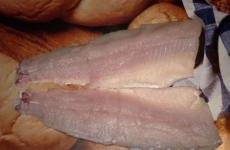My coconut macaroon. Coconut Macaroni - cooking and dancing! Coconut Cream Chantilly
Honestly, when I first saw his new idea, I looked at the photo for quite a long time. It would seem that one insignificant detail in the assembly and how much it is transformed, the final result changes. I would even come up with some kind of special gradation or caste just for this one species.
The most important detail that is necessary in order to make a “flip” is that after baking you should have a perfect bottom, smooth, without a single “torn” place, just a thin, beautiful crust. Only in this case will it look elegant and graceful.
Otherwise, everything is the same - the base is French meringue, the filling is coconut ganache and strawberry jelly. Tasty, bright, unusual and beautiful.
If you still have questions: What are aged proteins? Why leave macarons out for an hour? Why did the cookies crack/the skirt did not appear? Please read this topic carefully: .
Ingredients:
100 g almond flour
60 g coconut flour (ground coconut)
225 g powdered sugar
125 g egg whites, aged
50 g sugar
1/2 tsp. red dye (liquid or dry on the tip of a knife)
Filling:
200g white chocolate, finely chopped
110 ml
50 g butter
2 tbsp. l. coconut flakes
1/2 vanilla pod
150 g strawberries
50 g sugar
2 tbsp. l. lemon juice
5 g gelatin
Preparation:
Mix almond flour, coconut flour and powdered sugar together. Grind again in a coffee grinder, food mill or blender. Sift.

Preheat the oven to 150C, pour the dry mixture onto a baking sheet lined with parchment paper and dry in the oven for 5 minutes. Then sift again.
Pour the dry ingredients into a bowl in which it will be convenient for you to knead the dough later.
Place the egg whites in a food processor or mixing bowl. Beat them until stable foam. Then gradually start adding sugar. Continue beating the egg whites until stiff peaks form. If you use dry coloring, add it to the egg whites at the very end of beating.
When you lift the whisk, the overhanging “spout” of whipped foam should form a “bird's beak.” And from the bowl, if you tilt it or turn it over, nothing should leak or fall.

Place the whites in a bowl with almond flour and begin to mix them gently with a silicone spatula, turning the bowl itself counterclockwise.
Stir for about 30 seconds, the mixture should not yet become completely homogeneous. Measure out the coloring and add it to the dough if you are using liquid coloring.
Continue stirring until the consistency and color are uniform. Your macaronade should flow from the silicone spatula in a thick ribbon and slowly spread out, forming a smooth surface of dough.

Place the resulting dough into a piping bag and pipe 3-4 cm diameter circles onto parchment paper or a silicone mat. If the dough is kneaded correctly, the “tails” will separate almost immediately, but the dough will not spread much.

Set them aside for 30-60 minutes. During drying, a very thin layer forms on the surface of the dough, which does not stick to your fingers - similar to a fragile crust. This crust remains intact during baking, and due to this, a “skirt” is formed at the bottom.
You can check their readiness as follows: lightly touch the surface of the cookies - if you feel a hard surface and nothing sticks to your finger, everything is ready. They will also change in appearance from glossy to matte.
Baking:
Preheat the oven to 155C.
Bake for approximately 13-15 minutes. If you have a larger diameter, increase the time by a couple more minutes.
You can open the oven slightly and try lifting one half of the macaron slightly by the cap - if it is movable, can be removed separately or comes away from the skirt - your cookies are still raw, continue baking for a few minutes.
Fully cooked, baked pasta will easily come off the surface, leaving nothing on either the paper or the mat.

Coconut cream:
Place the chocolate in a deep bowl.
Pour the coconut milk into a small saucepan and add the split vanilla bean and vanilla seeds. Bring to a boil.

Pour the hot vanilla-coconut mixture into the chocolate. Wait 30 seconds and then begin to stir slowly until the chocolate is completely melted and the mixture is smooth.

Add butter and coconut flakes. Stir until smooth.

Place in the refrigerator until the filling thickens.
Soak the gelatin in cold water and let it swell.
Puree the strawberries in a blender. Add sugar and lemon juice and blend again for a few seconds.
Heat 1/3 of the strawberry puree in a small saucepan, add gelatin and stir until dissolved. Then combine this mixture with the remaining strawberry puree.
Pour the future jelly into a mold covered with cling film so that the thickness is no more than 0.5 cm.
Place in the refrigerator until completely frozen.
Assembly:
Take out the cream and jelly.

Place the coconut-vanilla cream into a piping bag fitted with a flat, round tip, about 1-1.5 cm in diameter.
You can also put the jelly in a pastry bag and simply cut off the tip. Or you can cut the jelly into small cubes.

Distribute the macaron halves according to size, but not in the usual way, but rather with the semicircular side facing each other.

Pipe the coconut-vanilla cream in a circle and place the jelly in the center. Cover with the other half of the macaron, half-round side down.

Sprinkle the sides of the cream with coconut flakes. Place the finished macarons in the refrigerator overnight.

Of course, if you wish, the assembly of these macarons can be standard.

Store in the refrigerator until serving. Serve chilled only.

Enjoy your tea!
Well, I’ll say a few more words about macaroon with hazelnuts. Since the taste of hazelnuts is more pronounced than, say, the taste of almonds, using both flours in 50/50 proportions, the taste of hazelnuts overwhelms the almonds to such an extent that the almonds are not noticeable at all, instead of the hazelnuts. So, dedication to all hazelnut lovers!
In principle, the recipe and preparation are exactly the same, except for one detail - instead of using only almond flour, we use 50% almond flour and 50% other flour (coconut flakes, hazelnut flour). Everything else is the same.
In the last post, I wrote that Tartelette, instead of leaving the whites at room temperature for a day, puts them in the microwave for 20 seconds, at intervals of 10 seconds. Following this instruction, I boiled the whites twice.
BUT, if you do smaller intervals (for example, 5 seconds), then everything works out. So here you need to adapt to your microwave.
I heated the two batches of macarons I made in the microwave and everything turned out great.
For the cream, I prepared 2 different creams.
For the coconut macarons, I made white chocolate ganache, and for the hazelnut macarons, I made dark chocolate ganache.
For the test:
100 gr. - proteins kept at room temperature for 1 day.
50 g - granulated sugar
A pinch of salt
50 g - almond flour (*1)
50 g - coconut flour/hazelnut flour
200 g - powdered sugar (*2)
- The day before making macarons, separate the whites from the yolks (from about 3 eggs) and leave the whites at room temperature. ***This helps excess moisture evaporate from the proteins. By following this step, the chance of making macarons increases by 100%. The whites can even be 2-3 days old, the main thing is to return the whites to the refrigerator after 24 hours, covering them with film. In this case, immediately before cooking, the whites must be returned to room temperature. This helps them whip up to maximum volume.
Tartelette suggests that you can achieve the same result by heating the whites in the microwave at intervals of 10 seconds (20 seconds in total). I tried it 2 times and 2 times they just cooked.*** - Before starting to prepare the macarons, turn the oven on to 300F.
- Lay out 2 baking sheets parchment paper ***important! Otherwise you won’t be able to peel off the macarons from the surface***
- Prepare a piping bag fitted with a 1.5cm round tip. ***The smaller the hole on the nozzle, the more air will come out when we squeeze out the dough, that is, if we started with a thick dough, when we squeeze out it will be liquid (spread). Because the larger the opening, the better***
- Blend the powdered sugar, almond flour and coconut/hazelnut flour in a blender (about 30 seconds). ***At this stage you can add loose paint if you want macarons of a certain color. ******This stage is important to remove all lumps of almond flour and powder. You can also simply sift through it, but I liked the result with a blender more, since it is more likely to be full and the powder and almonds are mixed more thoroughly***
- Measure 100 g with scales. whites (from about 3 eggs), sprinkle with a pinch of salt and beat with a mixer until soft peaks form. ***it is important to measure, since eggs are different and if they are too large, the dough will be runny, if they are too small, it will be thick. By measuring, we ensure success, every time***
- Continuing to beat, add 1 tablespoon of sugar.
- Beat until pearly color and stable peaks.
- Pour the dry ingredients into the whites and stir with a circular, quick movement of a spoon or spatula until the ingredients are almost completely mixed (about 12-15 circular movements), then continue to wrap the mass with slow movements until all the dry ingredients are completely mixed into the “dough”.
***It is important here to knead exactly a certain number of times so that the dough is not very thick (when you squeeze the dough out of the bag, in this case the “tip” sticks out without falling), but also not very liquid (it spills a lot, in very flat cake). That is, as soon as all the dry ingredients are mixed and the dough is still thick, after that, you will literally need to wrap the dough a couple of times to make it more liquid.*** - Fill a pastry bag with dough and squeeze circles 2-3 cm in diameter onto parchment paper (press, lift/tear method)
- At this stage, if you want to sprinkle the macarons with something, then this should be done now, while they are still “wet” and the sprinkles will stick.
- Leave the macarons on the table for 30-60 minutes so that they form a crust ***if you skip this step, nothing will change at all***
- Place the baking sheet in the oven, insert a wooden spoon into the gap between the door and the oven.
- Bake for 10-12 minutes.
- Remove from the oven and let the macarons cool.
- Remove from parchment paper
2. When choosing powdered sugar, take powder from a good and well-known company, since usually in cheap types the ratio of powdered sugar to starch (so that the powdered sugar does not stick together, + starch is cheaper) is very high, and starch will not give a good result. Instead of them looking like macarons, they will look like regular egg white cookies without the kick.
Ganache-
100 dark/white chocolate
100 cream
Chop the chocolate.
Bring the cream to a boil. Remove from the stove.
Fold chocolate into cream.
Let stand for a minute or two.
Stirring halfway through until a homogeneous emulsion is obtained.
Allow to cool and thicken.
Transfer the ganache into a pastry bag.
Squeeze a little cream onto the bottom of 1 half of the macaroon and cover with the other half.
For macarons with white chocolate and raspberries, squeeze out the cream in a circle, leaving a void in the middle.
Place the raspberries in the middle of this circle.
Close the macaron with the other half.
Hello!
The urge to forget proteins in the refrigerator after preparing mayonnaise does not subside, which means macaron baking continues. We seem to have sorted out the chocolate ones. We’re just getting ready for green in color and matcha tea. But today we’ll try to figure out coconut macarons. Looking ahead, I’ll say right away: they didn’t work out. That is, it worked, but not quite. Too little protein was taken, the dough turned out to be tight, and therefore the skirt - a distinctive feature of this cookie - turned out to be weakly expressed. But this did not affect the taste, so the experiment can be considered a success.
I took coconut shavings, poured them into a baking tray and dried them in the oven.
And then, in portions, I crushed it in a coffee grinder with a spice attachment.
Still no flour. The mass contains too much moisture and oil (c) Iodine. Therefore, armed with a sieve with a fine mesh (for pathos, use the expression “sieve with a fine mesh”), I sifted the coconut flour into a deep bowl,
and then mixed with powdered sugar.
Beat the egg whites to soft peaks, then add 2 tablespoons of fine sugar and beat until glossy and stiff peaks, at which the mixture can be easily held over your head without fear, causing a storm of applause from the sophisticated public.
I introduced the dry mixture into the whites in portions and kneaded them in a circular motion with a silicone scraper (it would be more pretentious to say “spatula”). By the way, note that the color of my device is pink. It was my mother-in-law who gave ME, a 100-kilogram man, a pink scraper. Well, God bless him. The color is not so important, the main thing is that the scraper itself is great. And how beautiful he is, the rhinestones there... Uh-uh, I digress.
I put the dough into a pastry bag and piped the pieces with a diameter of 2.5-3 centimeters.
Dried at room temperature for an hour. Preheated the oven to 180 degrees (at least, set this value on the broken thermostat). Bake for 8 minutes, after 4 minutes rotating the pan 180 degrees. I took the cookies out of the oven, let them cool and removed them from the paper.
I made the buttercream by creaming room temperature butter and powdered sugar. I molded the cookies in pairs and coated them with cream.
Wow!
Ingredients:
Coconut flakes - 250 gr.
Powdered sugar - 200 gr.
Egg white - 4 pcs.
Fine sugar - 2 tbsp. spoons
230 grams butter
250 grams of powdered sugar
Notes.
If you're going to do it again.
Increase the amount of proteins by 1.5 times, that is, you will need 6 proteins. The cookies turned out very sweet, so it is better to omit the sugar and divide the powdered sugar for the cookies in half, mix one half with coconut flour, and the other half into the egg whites. Cream. The cream is too fatty for such cookies, it is better to replace it with fruit, for example, take black currants, roll with sugar and strain through a fine sieve, getting rid of the seeds. Then add gelatin or gelfix diluted in water, wait until thickening begins, and grease the cookie halves with the resulting jam. You can make something like marshmallows by whipping egg whites and steeping them in a gelatin solution brought to a boil. In general, whatever your imagination shows.
We prepared classic macarons, we also baked chocolate ones... In general, we are starting to experiment! Coconut pasta will especially appeal to lovers of all kinds of heavenly pleasures - they taste somewhat reminiscent of Raffaello sweets, but more refined and delicate. The cooking principle is not much different from other pasta, so before starting the process, I recommend reading. Well, don’t forget that any cooking, especially desserts, should bring joy and pleasure, so I suggest dancing and having fun in the process, that’s pretty much how I do it in the video! In general, I suggest you have a blast like a coconut! ;)
Cooking time: 30 minutes
Setting time for pasta: 15-30 minutes
Baking time: 10 minutes per baking sheet
For 50-55 cakes
Ingredients:
- 250 g Powdered Sugar
- 250 g Almond Flour (Powder) -
- 90 g + 90 g Egg Whites
- 250 g Sugar
- 75 ml Water
- Coconut flakes
Coconut Cream Chantilly:
- 200 g Cream 35%
- 60 g Powdered Sugar
- 1-2 tsp. Vanilla Extract or Paste
- 60 g Coconut flakes
Cooking method:
Mix almond flour, powdered sugar and sift everything together. Add egg white, half of the total amount, leave the rest for beating. You need to mix everything well, turning it into almond paste.
Next we prepare. Dilute the sugar with water and place on moderate heat. When the syrup boils, begin to beat the remaining whites at low speed. The syrup can be stirred very carefully directly with a thermometer - with a spatula you can spill it too much on the walls. When its temperature reaches 110ºC, increase the speed of beating the whites to maximum and continue heating. Having reached 118ºС, remove the syrup from the heat and add it in a thin stream to the whipped whites, without stopping the mixer. We do not stop whipping, but reduce the speed to medium - now the meringue needs to be allowed to cool (to about 40-45ºC) and whipped into stiff peaks or, as the French say, until bird beaks.
Mix the whipped meringue into the almond paste in three stages, thoroughly and quickly enough, but carefully. As a result, we get a viscous mixture that flows from the spatula in a thick ribbon, rather than falling in pieces. We transfer it into a cooking bag and place the halves of the future pasta on a baking sheet covered with cooking paper or a silicone substrate, leaving space between them and trying to stick to the same size. To make it easier to stick to straight lines and the same diameter, you can draw auxiliary lines directly on the cooking paper with a pencil. When there is not enough experience, this helps. After the baking sheet is ready, it must be lifted several times and thrown onto the table, strictly vertically. This will help remove excess air bubbles and make the surface of the pasta smoother. After this, sprinkle the pasta a little with coconut, finally blowing it a little on the baking sheet so that the edges of the pasta are also sprinkled. It is better to take smaller chips; if necessary, chop additionally using a blender.
Leave the baking sheets for 15-30 minutes (depending on temperature and air humidity). Meanwhile, preheat the oven to 150ºC. The pasta should set and if you touch it with your finger, it should not stick or leave marks. If this is not done, then the pasta may swell, crack and explode in the oven - then all is lost. Therefore, take your time - it is better to wait a little longer. Place the baking sheet with the “set” pasta into the preheated oven, close the door and lower the temperature to 140ºC. The pasta should be baked for 10 minutes; at the 6th minute, when the characteristic “skirts” have already formed, it is recommended to quickly open the oven and turn the baking sheet over so that the cookies dry evenly. The main thing is to wait until the “skirts” appear before turning them over. After the oven, after a couple of minutes, remove the pasta from the baking sheet, moving it directly on the paper or silicone substrate to a wire rack so that they begin to cool.

Preparing coconut Chantally. Whip very cold cream with powdered sugar and vanilla extract or paste. Bring to a stable creamy state and add coconut flakes. Here it needs to be crushed to a state close to powder, that is, made very fine.

Using a pastry bag, spread small amounts of cream onto the pasta halves, exactly in the middle. And cover with the other halves. The amount of cream is according to your taste - some people like a thick layer, others prefer a thinner layer.
It is better to store pasta in the refrigerator, in a tightly closed container. Bon appetit!


Strawberry coconut macarons March 8th, 2013

Today is March 8th! Work has officially started! Bring women flowers, sweets, beautiful underwear, shoes and cosmetics! You can also have interesting books, tickets to the theater, to a concert, trips to hot countries are also not forbidden;) But, most importantly, give us love and care! Spring has come, which means that there is only warmth, only sun and joy ahead!
I have prepared a sweet gift for my readers: a recipe for strawberry-coconut macaroons. They have a very rich taste and quite extraordinary, I tell you =) The appearance, in my opinion, of these macarons turned out worse than the first ones, but this is only the second time I made them. There is something to strive for!
I took the recipe from Nina Niksya.
Ingredients:
100 g almond flour
60 g coconut flour (ground coconut flakes)
125 g egg whites (aged and room temperature)*
225 g powdered sugar
50 g sugar
1/2 tsp red liquid coloring (or dry on the tip of a knife)
*Aged whites are egg whites that have been in the refrigerator for at least 24 hours and are allowed to "come" to room temperature before using. What is it for? During this time, the protein structure changes, causing them to become thinner, and subsequently, a better texture is achieved for the macarons.
Preparation:
In a separate bowl, mix almond flour, coconut flour and powdered sugar together and stir to combine. If necessary, grind again in a coffee grinder/blender. Sift.
Preheat the oven to 150 C or 300 F.
Line a baking sheet with parchment paper and pour the dry mixture onto it. Flatten and place in the oven for 5 minutes to dry. Then take it out, sift it again in the bowl and set it aside.

Pour the whites into a deep form and beat until they form stable shapes. Then gradually add sugar, continuing to beat until stiff peaks form. If you have dry dye, add it to the whites before the end of beating. By lifting the whisk, the tip of the whites should bend, forming a “bird’s beak”, and when turning the mold over, nothing should leak out or fall on the table.

Place the whites in a bowl with flour and powdered sugar and gently begin to mix with a spatula in a bottom-up motion, while turning the bowl counterclockwise. Stir for about 30 seconds until the mixture becomes homogeneous. If using liquid coloring, add it to the dough. Continue stirring until texture and color are uniform. When you lift the spatula, properly mixed macaron dough should flow down in a thick ribbon and slowly spread apart.

Prepare baking sheets and line them with parchment. Place the dough into a cooking bag with a round attachment (or without it, simply cut off the tip of the bag. The diameter should be 5-6 mm) and pipe neat circles onto the paper. The classic size of macarons is 3-4 cm in diameter. If the dough is kneaded correctly, the “tails” of the circles will quickly disperse, but they themselves will not spread.

Set them aside for 30-60 minutes. This time is needed to dry the macarons: an extremely thin layer forms on the surface, similar to a very fragile crust, and does not stick to your fingers. Thanks to this crust, the macarons form a beautiful “skirt” during baking. Also, their surface will turn matte from the original glossy one.
Important! If the room is humid enough, the macarons can stand for 2 hours, but they will not be covered with the coveted crust. It is absolutely forbidden to put them in the oven in this form! They will crack, lose their shape and there will be no “skirt”. Therefore, you need to dry them in the oven: heat it to 80 C or 175 F and put the macarons there for 5 minutes. Then take it out, let it stand for 5-7 minutes and you can start baking!
Preheat the oven to 150 C or 300 F. Bake the macarons for 13-15 minutes. You can check their readiness: open the oven slightly and try to lift the cap of one mug. If it comes off and moves away from the skirt, it means the cake is not baked yet and you need to leave it in the oven for a few minutes.
Ready and baked macarons easily come away from the paper on which they were baked, leaving nothing behind. Let them cool completely.
Coconut cream
Ingredients:
135g white chocolate, finely chopped
75 ml coconut milk
35 g butter
2 tbsp coconut flakes
1/2 vanilla pod
Preparation:
Place the chocolate in a deep bowl. Cut the pod in half lengthwise, peel off the seeds and place everything together in a small saucepan with coconut milk. Boil. Pour the hot mixture into the chocolate. Wait 30 seconds and then slowly begin stirring until the mixture is smooth and the chocolate has dissolved. Add oil and coconut flakes, mix again. Place in the refrigerator until completely frozen.

Ingredients:
75 grams of fresh strawberries (you can take frozen ones, but first let them thaw at room temperature and allow excess liquid to drain)
25 g sugar
1 tbsp lemon juice
3 g gelatin
Preparation:
Dilute the gelatin with cold water and let it swell.
Peel the strawberries from the stems (if fresh) and puree them in a blender. Add sugar and lemon juice and beat for a few more seconds.
Heat 1/3 of the strawberry puree in a small saucepan, add gelatin and stir until it dissolves. Then combine with the remaining puree and mix.

Cover a flat pan with cling film and pour the jelly onto it. Its thickness should be no more than 5 mm. Place in the refrigerator until completely frozen.

Place the coconut cream in a piping bag fitted with a round tip. Cut the jelly into portion cubes, approximately 5 mm. Place the jelly in the center of the flat part of the macaroons and pipe the cream around it, being careful not to press too close to the edge (later the cream may start to flow).

Cover with the other half. Place the finished macarons in the refrigerator overnight and store there until serving**. Enjoy!
** Cooling and the “ripening” process is an extremely important stage for macarons. Ideally, they should be refrigerated for 24 hours to reach the desired state where their flavor is fully developed.







